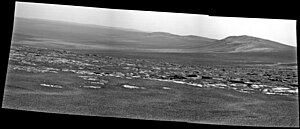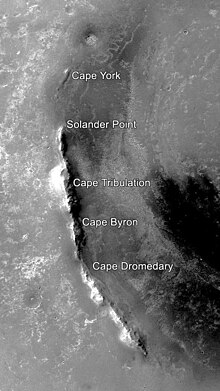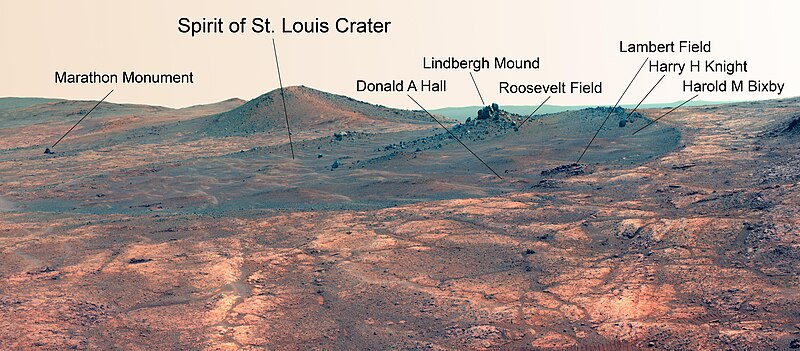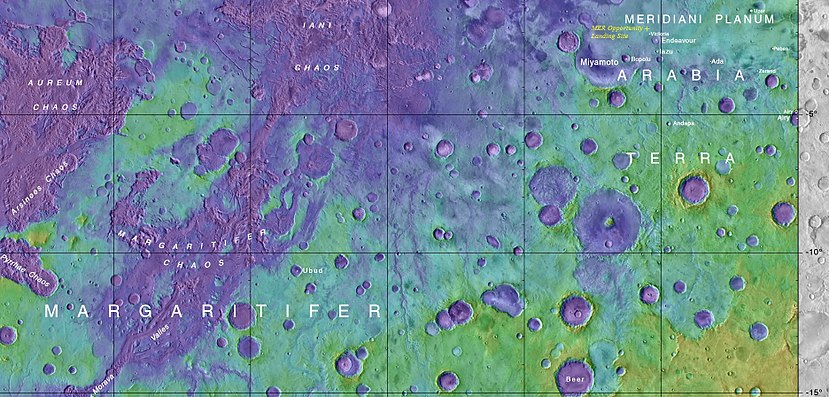 | |
| Planet | Mars |
|---|---|
| Region | Meridiani Planum |
| Coordinates | 2°17′S 5°14′W / 2.28°S 5.23°W |
| Quadrangle | Margaritifer Sinus |
| Diameter | 22 kilometers (14 miles) [1] |
| Depth | 300 meters (980 feet) [2] |
| Eponym |
Endeavour, Saskatchewan, Canada (official name)
[3] HM Bark Endeavour (for early informal nickname) [4] |



Endeavour is an impact crater located in the Meridiani Planum extraterrestrial plain within the Margaritifer Sinus quadrangle (MC-19) region of the planet Mars. Endeavour is about 22 kilometers (14 mi) in diameter. [1] Using Mars Reconnaissance Orbiter data, phyllosilicate-bearing outcrops have been detected along its rim. These minerals may have formed under wet conditions in a low-acidic environment during the early history of Mars. [5] There are raised rim segments to the north, east, and southwest. The rim has become worn, rounded and degraded, with infilling of plains material in a manner similar to the Victoria crater. [6]
When compared to the surrounding plains, the crater floor shows an enhanced spectral signature of basalt and hematite. [7] The interior contains two groups of dune fields. Images taken since 2008 show evidence of changes in some of the associated formations, which may be evidence of active erosion by the martian wind over a period of two to three years. [6] The plains surrounding the rim show evidence of polyhydrated sulfate. [7]
The Mars Exploration Rover-B Opportunity began travelling toward this crater in August 2008, [1] with the rim coming into sight on March 7, 2009, [8] and arriving at the edge on August 9, 2011. [9]
Endeavour averages about 200 to 300 metres (660 to 980 ft) deep, with an area in its southeast that goes down to 500 metres (1,600 ft) deep, according to a publication called Degradation of Endeavour Crater, Mars by the Smithsonian Institution. [10] The south-west depression goes down to an elevation of −1,980 metres (−6,500 ft), the horse-shoe shaped depression sits in the south-east quadrant and is around minus −1,800 to −1,900 metres (−5,900 to −6,200 ft) elevation, which is about 400 metres (1,300 ft) below the surrounding plains. [10] It is noted that the crater has undergone various erosion processes, with wind being one cause. [10]
Nomenclature
The International Astronomical Union named the crater after a town in Canada. [3] The name was approved on 20 October 2008. [11] Due to rules for naming craters, it is officially named after the Canadian town, but the reason this name was proposed was because rover team was using informal nicknames based on a voyage of HMS Endeavour. [4]
An informal working nickname by the Mars mission for the crater was Endeavour, and features of it, are based on the voyage of HM Bark Endeavour, [4] a British Royal Navy research vessel commanded by Lieutenant James Cook on his first voyage of discovery, to Fiji, New Zealand and Australia from 1769 to 1771, using Australian places named by James Cook. Examples include: Cape Dromedary, Point Hicks, Byron Bay, Cape Tribulation, Cape Byron, and Cape York. [12] The purpose of the voyage was to observe the transit of Venus, to accurately measure the distance to the Sun, then to explore lands found on the return journey.
Geology
The crater is understood by the 2010s to have two main rock types, the Shoemaker Formation and the Matijevic Formation. [13] It has been classified as a complex crater and it is thought to be so old many of its features have been worn away. [13] Some questions were raised about the tilt of the rim, however understanding is hampered by a lack of knowledge about Martian impact craters: Endeavour was the largest Martian impact crater up to that time to be studied that closely. [13] An example of the difficulty of studying Mars features is also apparent with Orcus Patera, which has various volcanic, tectonic, or cratering events explanations for its formation. [14] One famous Mars realization was that what was then called Nix Olympica was a volcano, and then renamed Olympus Mons thanks to Mariner 9 orbiter observations in the early 1970s. [15] Endeavour was identified as having clay minerals, as detected from orbit by Mars Reconnaissance Orbiter, which according to theories at that time indicated rock from an older, wetter, time period on Mars. [16] This type of rock is different from what prevails in other areas of surrounding plains. [16]
What is expected to be a fluid-carved gully was identified at Endeavour, probably water. [17] This gully is targeted for exploration by the MER-B rover mission as of October 2016. [17] It reached the gully in 2017 and it was named Perseverance Valley
Mineral map of surrounding

Western rim





- Cape York (Mars), at the northern end of the Eastern rim [19]
- Sutherland Point [19]
- Nobby's Head, just below Cape York
- Botany Bay, an open area between Cape York and Solander Point
- Solander Point
- Murray Ridge
- Pilinger Point [10]
- Widowak Ridge [10]
- Ulysses crater [20]
-
Cape Tribulation
- Marathon Valley
- Spirit Mound
- Cape Bryon [21]
- Perseverance Valley, erosion network in this section of the rim, reached by MER-B in 2017 [22]
- Cape Dromedary
- Point Hicks
- Torres Strait (from the end of Point Hicks to Batavia on the southern rim)
The next rim section proceeding counter-clockwise around the crater is Batavia, on the southern end of the whole crater but East of Torres Strait
Western rim mineral map

Western rim elevation

Western rim

Western rim sections from Solander to Marathon
3492 (November 2013)

3500 to 3689 (June 2014)

3728 to 3757 (August 2014)
Roughly in the center is Ulysses crater, visited by MER-B around Sol 3790 (September 2014) [20]

3750 to 3869 (December 2014)
Ulysses crater is roughly top-center location, visited by MER-B around Sol 3790 (September 2014) [20]

3870 to 4209 (December 2015)

October 2016 (with labels)
Explored in by the MER-B rover, several locations including the crater Spirit of St. Louis with Lindberg Mound, Marathon Valley, Lewis and Clark pass, and Spirit mound among other features on or very near the Western rim

to 4625 (January 2017)

to 4695 (April 2017)
Cape Tribulation and Cape Bryon

Up to 4836 (September 2017)
Throughout 2017, Opportunity worked its way south along the Western rim as it moved towards the gully, which the team named Perseverance Valley in April 2017. [22] [25]


Eastern rim



Opportunity
MER-B has had such new discoveries at the crater, that the rover team compared Endeavour to the equivalent of a second landing site for Opportunity. [29] [30] For example, On sol 2692 (August 22, 2011) the rover began examining Tisdale 2, a large ejecta block. "This is different from any rock ever seen on Mars," said Steve Squyres, principal investigator for Opportunity at Cornell University in Ithaca, New York. [29]


The journey to Endeavour

In August 2008, Mars Exploration Rover-B Opportunity set to reach Endeavour and began a journey towards it. [1] [31] Some craters that were previously explored by Opportunity include the crater Victoria which is 750 meters (0.47 miles) in diameter, Endurance crater which is 130 meters (0.081 miles) in diameter, and the crater Eagle which is 22 meters (0.014 miles) in diameter. [32] [33] [34]
On March 7, 2009 (sol 1,820), Opportunity first imaged the rim of Endeavour after driving about 3.2 kilometers (2.0 mi) since it left Victoria in August 2008. [8] [35] Opportunity also imaged the crater Iazu, which is about 38 kilometers (24 mi) away and about 7 kilometers (4.3 mi) in diameter. [35] At that time, Opportunity was 12 kilometers (7.5 mi) from Endeavour as the Martian crow flies, but to avoid hazards, it was estimated that it would take about 30% more driving distance than that to reach Endeavour. [8] Based on the amount of time it had taken to drive from Victoria, it was estimated that this journey would take over one Martian year (23 months). [8] On May 5, 2010, to avoid hazardous dune fields along the direct path between Victoria and Endeavour, the charted route between the two craters was extended to an estimated 19 kilometers. [36]
On September 8, 2010, it was announced that Opportunity had reached the halfway point of the 19-kilometer journey between Victoria and Endeavour. [37] By June 28, 2011, Opportunity was just under 2 kilometers (1.2 mi) from landfall at the rim of Endeavour. [38]
On August 4, 2011, Opportunity was only 120 meters (390 ft) from the rim of Endeavour, [39] and on August 9, 2011 Opportunity arrived at the west rim near Spirit Point to study outcrops never seen before. [9]
When it arrived it explored the northwest outcrops at Cape York (Mars) of the crater before heading south to Solander Point and the Western rim. [40]



Solander point


Homestake Vein

In December 2011, Opportunity rover discovered a vein of gypsum sticking out of the soil along the rim of Endeavour. Tests confirmed that it contained calcium, sulfur, and water. The mineral gypsum is the best match for the data. It likely formed from mineral-rich water moving through a crack in the rock. The vein is called "Homestake." It could have been produced in conditions more neutral than the harshly acidic conditions indicated by the other sulfate deposits; hence this environment may have been more hospitable for a large variety of living organisms. Homestake is in a zone where the sulfate-rich sedimentary bedrock of the plains meets older, volcanic bedrock exposed at the rim of Endeavour. [41] [42]
Wdowiak Ridge
A view looking north-north west with the Western and Northwest Endeavour segments

Proximity to Schiaparelli landing ellipse
In October 2016 ESA's Schiaparelli lander attempted to re-use the proven Meridiani Planum landing site, with a landing ellipse that kisses the Endeavour crater location where Opportunity was still functioning. [44] This allowed the opportunity for Opportunity to attempt to image the lander during its descent from the surface of Mars. [44] Contact was lost during descent

Proximity to MSL landing site candidates
Two of the seven final landing candidates for MSL were relatively near to Endeavour, one was in Miyamoto (crater) and another was south of Endeavour in southerner Meridiani. [46] Gale (crater) won the selection

Cape Tribulation
MER-B from 2011 to 2016 explored the Western rim of Endeavour, starting at Cape York (Mars) then moving down through Botany Bay to Solander Point, along Murray Ridge moving south to Marathon Valley; in late 2016 it began moving inward to the crater floor: It then moved back to the rim and went south to gully named Perseverance Valley, leaving the Cape Tribulation section, and heading towards Cape Bryon.




Spirit of St. Louis
This crater sits at the Western mouth of Marathon Valley, south Cape Tribulation on the western rim of Endeavour. It was visited by the MER-B Opportunity rover in May 2015. [50]
Above Perseverance Valley by Opportunity
Perseverance Valley is an erosion network in the Cape Bryon section of the Western Endeavour rim. [22] It was named in April 2017 by the MER-B team, which previously referred to it as the gully. [22]

Context

-
Map showing the location of Endeavour and other, nearby features
Comparison
Endeavour is about the same size as Valles Caldera in the U.S. State of New Mexico, a volcanic Caldera of the Valles Caldera National Preserve. [20] Endeavour has been compared to the Mars craters' Santa Fe (crater), which is about 20.2 km in diameter, and also to Tooting (crater), which is 27.5 km in diameter. [10]
See also
- List of craters on Mars
- Geography of Mars
- Cape York (Mars) (Point on western ridge where Mars rover Opportunity arrived at in 2011)
- Solander Point (Point on western ridge ascended by a Mars rover Opportunity in 2013)
- Nearby Locations in Meridiani Planum:
References
- ^ a b c d "NASA'S Mars Rover to Head Toward Bigger Crater". NASA/JPL. 2008-09-22. Retrieved 2009-03-20.
- ^ "Road Trip Gets Under Way". NASA/JPL. 2008-09-24. Retrieved 2009-04-27.
- ^ a b "Planetary Names: Crater, craters: Endeavour on Mars". Gazetteer of Planetary Nomenclature. Retrieved 2016-02-14.
- ^ a b c "Mars Exploration Rovers Update: Opportunity Embarks on New Endeavour, Spirit Gets Back To Normal Schedule | The Planetary Society". planetary.org. Retrieved 2018-08-16.
-
^ Wray, J. J.; et al. (November 2009), "Phyllosilicates and sulfates at Endeavour Crater, Meridiani Planum, Mars", Geophysical Research Letters, 36 (21): L21201,
Bibcode:
2009GeoRL..3621201W,
doi:
10.1029/2009GL040734
{{ citation}}: CS1 maint: multiple names: authors list ( link) - ^
a
b Chojnacki, M.; Burr, D. M.; Moersch, J. (March 2010), "Recent Dune Changes at Endeavour Crater, Meridiani Planum, Mars, from Orbital Observations", 41st Lunar and Planetary Science Conference, held March 1–5, 2010, The Woodlands, Texas, p. 2326,
Bibcode:
2010LPI....41.2326C
{{ citation}}: CS1 maint: location missing publisher ( link) - ^
a
b Chojnacki, M.; Moersch, J.; Wray, J. J.; Burr, D. M. (March 2010), "The Stratigraphy, Composition and Thermophysical Properties of Endeavour Crater, Meridiani Planum, Mars, from Orbital Remote Sensing", 41st Lunar and Planetary Science Conference, held March 1–5, 2010, The Woodlands, Texas, p. 2175,
Bibcode:
2010LPI....41.2175C
{{ citation}}: CS1 maint: location missing publisher ( link) - ^ a b c d "One Mars Rover Sees A Distant Goal; The Other Takes A New Route". NASA/JPL. 2009-03-18. Retrieved 2009-03-20.
- ^ a b "NASA Mars Rover Arrives at New Site on Martian Surface" (Press release). NASA/JPL. 2011-08-10. Archived from the original on 2012-11-03. Retrieved 2016-02-14.
- ^ a b c d e f "Degradation of Endeavour Crater, Mars" (PDF). 2015-03-27. Retrieved 2018-08-16.
- ^ "Martian Crater Named Endeavour". USGS Astrogeology Science Center. 2008-10-20. Retrieved 2016-02-14.
- ^ "NASA Mars Rover Seeing Destination in More Detail". Mars Exploration Rover Mission: Press Release Images: Opportunity. 29 June 2010. Archived from the original on 2011-09-28. Retrieved 2022-12-31.
- ^ a b c "Endeavour rim rocks slope "wrong" way | Red Planet Report". redplanet.asu.edu. Retrieved 2018-08-16.
- ^ "HRSC Press Release #471 - Orcus Patera (orbit 2216 & 2238)". 2010-08-27. Archived from the original on 2014-08-07.
- ^ "ch9-4". solarviews.com. Retrieved 2018-08-16.
- ^ a b "NASA Rover Arrives at Huge Mars Crater After 3-Year Trek". space.com. 10 August 2011. Retrieved 2018-08-16.
- ^ a b "News | NASA's Opportunity Rover to Explore Mars Gully". jpl.nasa.gov. Retrieved 2018-08-16.
- ^ mars.nasa.gov. "Mars Exploration Rover Mission: Multimedia: All Raw Images: Opportunity: Navigation Camera: Sol 4959". mars.nasa.gov. Retrieved 2018-08-16.
- ^ a b c d "Mars Exploration Rovers Update: Opportunity Heads for New Discovery as Winter Blows In at Cape York | The Planetary Society". planetary.org. Retrieved 2018-08-16.
- ^ a b c d "Sol 3790 | New Mexico Museum of Natural History & Science". nmnaturalhistory.org. Retrieved 2018-08-16.
- ^ "NASA's Mars Rover Opportunity Leaves 'Tribulation' – NASA's Mars Exploration Program". mars.nasa.gov. Retrieved 2018-08-16.
- ^ a b c d "Mars Exploration Rovers Update: Opportunity Dodges Dust Storms, Makes Tracks to Perseverance Valley". www.planetary.org. Retrieved 2018-02-08.
- ^ "Space Images | Geologic Map, West Rim of Endeavour, Mars". jpl.nasa.gov. Retrieved 2018-08-16.
- ^ mars.nasa.gov. "Mars Exploration Rover Mission: the Mission". mars.nasa.gov. Retrieved 2018-08-16.
- ^ "The Mars Exploration Rovers Update: Opportunity Closes in on Perseverance Valley". www.planetary.org. Retrieved 2018-02-08.
- ^ mars.nasa.gov. "Mars Exploration Rover Mission: the Mission". mars.nasa.gov. Retrieved 2018-08-16.
- ^ "Martian 'Perseverance Valley' in Perspective (Vertical Exaggeration) – NASA's Mars Exploration Program". mars.nasa.gov. Retrieved 2018-08-16.
- ^ "HiRISE | Eastern Rim of Endeavour (ESP_012477_1775)". hirise.lpl.arizona.edu. Retrieved 2018-08-16.
- ^ a b Fitzpatrick, Tony (14 September 2011). "Opportunity on verge of new discovery".
- ^ "NASA's Mars Rover Opportunity begins study of Martian crater". DefenceWeb. September 6, 2011.
- ^ Rahl, A.J.S. (2008-10-31). "Spirit "Bumps" a Move, Opportunity Puts the Pedal to the Metal". Planetary Society. Archived from the original on 2012-10-21. Retrieved 2009-03-20.
- ^ "NASA Rover Nears Martian Bowl Goal". NASA/JPL. 2006-09-06. Archived from the original on 2006-09-29. Retrieved 2009-03-20.
- ^ "Press Release Images: Opportunity". NASA/JPL. 2004-05-03. Archived from the original on 2004-11-17. Retrieved 2009-03-20.
- ^ "NASA Facts: Mars Exploration Rover" (PDF). NASA/JPL. 2004-10-24. Archived from the original (PDF) on 2009-03-27. Retrieved 2009-03-26.
- ^ a b "One Mars Rover Sees A Distant Goal; The Other Takes A New Route". NASA/JPL. 2009-03-18. Retrieved 2009-03-20.
- ^ "Opportunity's Long and Winding Road to Endeavour Crater". Universe Today. 2010-05-05. Retrieved 2010-08-04.
- ^ "Opportunity Rover Reaches Halfway Point of Long Trek". NASA/JPL. 2010-09-08. Retrieved 2010-09-11.
- ^ "Opportunity Is Just Over a Mile From Crater Rim". NASA/JPL. 2011-07-08. Archived from the original on 2014-06-20. Retrieved 2011-07-08.
- ^ "Nearing First Landfall of Large Crater". NASA/JPL. 2011-08-04. Archived from the original on 2014-06-20. Retrieved 2011-08-08.
- ^ "Mars Exploration Rover Mission: All Opportunity Updates". marsrovers.jpl.nasa.gov. Archived from the original on 2014-06-20. Retrieved 2018-08-16.
- ^ "NASA - NASA Mars Rover Finds Mineral Vein Deposited by Water". NASA. Archived from the original on 2017-06-25. Retrieved 2018-08-16.
- ^ "NASA - NASA Mars Rover Finds Mineral Vein Deposited by Water". Archived from the original on 2017-06-15. Retrieved 2022-07-21.
- ^ "Catalog Page for PIA18614". photojournal.jpl.nasa.gov. Retrieved 2018-08-16.
- ^ a b "Schiaparelli Lander to Touch Down on Mars - Sky & Telescope". skyandtelescope.com. Retrieved 2018-08-16.
- ^ Webster, Guy (21 October 2016). "Camera on Mars Orbiter Shows Signs of Latest Mars Lander". NASA. Retrieved 2016-10-24.
- ^ a b JPL, NASA. "Seven Possible MSL Landing Sites - Mars Science Laboratory". mars.nasa.gov. Retrieved 2018-08-16.
- ^ "Catalog Page for PIA20749". photojournal.jpl.nasa.gov. Retrieved 2018-08-16.
- ^ "Catalog Page for PIA21497". photojournal.jpl.nasa.gov. Retrieved 2018-08-16.
- ^ "Streaks on Opportunity Solar Panel After Uphill Drive – NASA's Mars Exploration Program". mars.nasa.gov. Retrieved 2018-08-16.
- ^ mars.nasa.gov. "Mars Exploration Rover Mission: Press Release Images: Opportunity | Martian Reminder of a Pioneering Flight". mars.nasa.gov. Retrieved 2018-08-16.
- ^ mars.nasa.gov. "Mars Exploration Rover Mission: Press Release Images: Opportunity | Martian Reminder of a Pioneering Flight". mars.nasa.gov. Retrieved 2018-08-16.
External links
- Official Mars Rovers website
- Opportunity: Iazu Crater profiles (As seen from rim of Endeavour crater)
- Endeavour crater as seen during MER-B's approach to the crater with some locations noted around the crater
- HiRise Analysis of the Western Rim of Endeavour Crater, Meridiani Planum, Mars: Morphology, Composition and Topography. University of Tennessee
- HiRise - search for Endeavour crater related images
- HiRise - DTM - North-Central Endeavour Crater
- HiRise - DTM - Endeavour Crater Western Rim
- DLR - ExoMars Schiaparelli's landing site on Mars 11 August 2016
- HRSC Viewer[ permanent dead link]
- HiRise image of the western rim
- Degradation of Endeavour Crater, Mars





